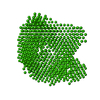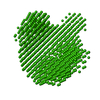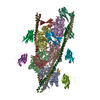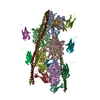+ Open data
Open data
- Basic information
Basic information
| Entry | Database: SASBDB / ID: SASDFJ7 |
|---|---|
 Sample Sample | Pseudomonas putida CBB5 mCherry-NdmA/ECFP-NdmB complex - static
|
| Function / homology |  Function and homology information Function and homology informationmethylxanthine N3-demethylase / methylxanthine N1-demethylase /  demethylase activity / alkaloid catabolic process / 2 iron, 2 sulfur cluster binding / demethylase activity / alkaloid catabolic process / 2 iron, 2 sulfur cluster binding /  oxidoreductase activity / oxidoreductase activity /  metal ion binding metal ion bindingSimilarity search - Function |
| Biological species |   Pseudomonas putida (bacteria) Pseudomonas putida (bacteria) |
 Citation Citation |  Journal: J Mol Biol / Year: 2019 Journal: J Mol Biol / Year: 2019Title: Structural and Mechanistic Insights into Caffeine Degradation by the Bacterial N-Demethylase Complex. Authors: Jun Hoe Kim / Bong Heon Kim / Shelby Brooks / Seung Yeon Kang / Ryan M Summers / Hyun Kyu Song /   Abstract: Caffeine, found in many foods, beverages, and pharmaceuticals, is the most used chemical compound for mental alertness. It is originally a natural product of plants and exists widely in environmental ...Caffeine, found in many foods, beverages, and pharmaceuticals, is the most used chemical compound for mental alertness. It is originally a natural product of plants and exists widely in environmental soil. Some bacteria, such as Pseudomonas putida CBB5, utilize caffeine as a sole carbon and nitrogen source by degrading it through sequential N-demethylation catalyzed by five enzymes (NdmA, NdmB, NdmC, NdmD, and NdmE). The environmentally friendly enzymatic reaction products, methylxanthines, are high-value biochemicals that are used in the pharmaceutical and cosmetic industries. However, the structures and biochemical properties of bacterial N-demethylases remain largely unknown. Here, we report the structures of NdmA and NdmB, the initial N- and N-specific demethylases, respectively. Reverse-oriented substrate bindings were observed in the substrate-complexed structures, offering methyl position specificity for proper N-demethylation. For efficient sequential degradation of caffeine, these enzymes form a unique heterocomplex with 3:3 stoichiometry, which was confirmed by enzymatic assays, fluorescent labeling, and small-angle x-ray scattering. The binary structure of NdmA with the ferredoxin domain of NdmD, which is the first structural information for the plant-type ferredoxin domain in a complex state, was also determined to better understand electron transport during N-demethylation. These findings broaden our understanding of the caffeine degradation mechanism by bacterial enzymes and will enable their use for industrial applications. |
 Contact author Contact author |
|
- Structure visualization
Structure visualization
| Structure viewer | Molecule:  Molmil Molmil Jmol/JSmol Jmol/JSmol |
|---|
- Downloads & links
Downloads & links
-Data source
| SASBDB page |  SASDFJ7 SASDFJ7 |
|---|
-Related structure data
| Related structure data | 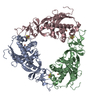 6ickC 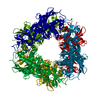 6iclC  6icmC  6icnC  6icoC  6icpC 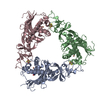 6icqC C: citing same article ( |
|---|---|
| Similar structure data |
- External links
External links
| Related items in Molecule of the Month |
|---|
-Models
| Model #3140 |  Type: dummy / Radius of dummy atoms: 6.75 A / Chi-square value: 0.419  Search similar-shape structures of this assembly by Omokage search (details) Search similar-shape structures of this assembly by Omokage search (details) |
|---|
- Sample
Sample
 Sample Sample | Name: Pseudomonas putida CBB5 mCherry-NdmA/ECFP-NdmB complex - static Specimen concentration: 4.40-11.00 / Entity id: 1700 / 1718 |
|---|---|
| Buffer | Name: 20 mM HEPES 150 mM NaCl 2 mM TCEP 10% v/v glycerol / pH: 7.5 |
| Entity #1700 | Type: protein / Description: Methylxanthine N1-demethylase NdmA / Formula weight: 69.001 / Num. of mol.: 3 / Source: Pseudomonas putida / References: UniProt: H9N289 Sequence: MGHHHHHHMV SKGEEDNMAI IKEFMRFKVH MEGSVNGHEF EIEGEGEGRP YEGTQTAKLK VTKGGPLPFA WDILSPQFMY GSKAYVKHPA DIPDYLKLSF PEGFKWERVM NFEDGGVVTV TQDSSLQDGE FIYKVKLRGT NFPSDGPVMQ KKTMGWEASS ERMYPEDGAL ...Sequence: MGHHHHHHMV SKGEEDNMAI IKEFMRFKVH MEGSVNGHEF EIEGEGEGRP YEGTQTAKLK VTKGGPLPFA WDILSPQFMY GSKAYVKHPA DIPDYLKLSF PEGFKWERVM NFEDGGVVTV TQDSSLQDGE FIYKVKLRGT NFPSDGPVMQ KKTMGWEASS ERMYPEDGAL KGEIKQRLKL KDGGHYDAEV KTTYKAKKPV QLPGAYNVNI KLDITSHNED YTIVEQYERA EGRHSTGGMD ELYKSGENLY FQGSMEQAII NDEREYLRHF WHPVCTVTEL EKAHPSSLGP LAVKLLNEQL VVAKLGDEYV AMRDRCAHRS AKLSLGTVSG NRLQCPYHGW QYDTHGACQL VPACPNSPIP NKAKVDRFDC EERYGLIWIR LDSSFDCTEI PYFSAANDPR LRIVIQEPYW WDATAERRWE NFTDFSHFAF IHPGTLFDPN NAEPPIVPMD RFNGQFRFVY DTPEDMAVPN QAPIGSFSYT CSMPFAINLE VSKYSSSSLH VLFNVSCPVD SHTTKNFLIF AREQSDDSDY LHIAFNDLVF AEDKPVIESQ WPKDAPADEV SVVADKVSIQ YRKWLRELKE AHKEGSQAFR SALLDPVIES DRSYI |
| Entity #1718 | Type: protein / Description: Methylxanthine N3-demethylase NdmB / Formula weight: 69.188 / Num. of mol.: 3 / Source: Pseudomonas putida / References: UniProt: H9N290 Sequence: MGHHHHHHMV SKGEELFTGV VPILVELDGD VNGHKFSVSG EGEGDATYGK LTLKFICTTG KLPVPWPTLV TTLTWGVQCF SRYPDHMKQH DFFKSAMPEG YVQERTIFFK DDGNYKTRAE VKFEGDTLVN RIELKGIDFK EDGNILGHKL EYNYISHNVY ITADKQKNGI ...Sequence: MGHHHHHHMV SKGEELFTGV VPILVELDGD VNGHKFSVSG EGEGDATYGK LTLKFICTTG KLPVPWPTLV TTLTWGVQCF SRYPDHMKQH DFFKSAMPEG YVQERTIFFK DDGNYKTRAE VKFEGDTLVN RIELKGIDFK EDGNILGHKL EYNYISHNVY ITADKQKNGI KANFKIRHNI EDGSVQLADH YQQNTPIGDG PVLLPDNHYL STQSALSKDP NEKRDHMVLL EFVTAAGITL GMDELYKSGL GSMKEQLKPL LEDKTYLRHF WHPVCTLNEF ERANASGHGP MGVTLLGEKL VLARLNSKII AAADRCAHRS AQLSIGRVCS NAGKDYLECP YHGWRYDEAG ACQLIPACPD KSISPRAKIS SFDCEVKYDI VWVRLDNSFD CTQIPYLSDF DNPDMQVIVA DSYIWETVAE RRWENFTDFS HFAFVHPGTL YDPFFASHPT VYVNRVDGEL QFKLAPPREM KGIPPEAPMG DFTYRCTMPY SVNLEIKLWK DDSRFVLWTT ASPVDNKSCR NFMIIVREKD NQPDHMHLAF QKRVLDEDQP VIESQWPLEI QTSEVSVATD KISVQFRKWH KELSLSAVEG REAFRDSVLT NVIEEEQ |
-Experimental information
| Beam | Instrument name: Pohang Accelerator Laboratory 4C / City: Pohang / 国: South Korea / Type of source: X-ray synchrotron Synchrotron / Wavelength: 0.0733 Å Synchrotron / Wavelength: 0.0733 Å | ||||||||||||||||||
|---|---|---|---|---|---|---|---|---|---|---|---|---|---|---|---|---|---|---|---|
| Detector | Name: Rayonix SX165 / Type: CCD / Pixsize x: 15 mm | ||||||||||||||||||
| Scan | Measurement date: Jul 27, 2018 / Storage temperature: 18 °C / Cell temperature: 4 °C / Exposure time: 5 sec. / Number of frames: 6 / Unit: 1/A /
| ||||||||||||||||||
| Distance distribution function P(R) |
| ||||||||||||||||||
| Result |
|
 Movie
Movie Controller
Controller


